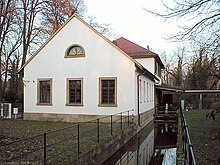Widmann's paper machine factory
The Widmann'sche paper machine factory in the Leintal in Neckargartach was a machine factory founded by Johann Jakob Widmann . Widmann had built the first continental European paper machine during the beginning of industrialization and produced it in a workshop in Heilbronn until 1840 , before he acquired the site in the Leintal and built a new factory there. Remains of a workshop building are still preserved from the plant, which was used as a paper mill after Widmann's bankruptcy , converted into a pumping station around 1900 and used as such until the 1960s. In the second half of the 1990s, the facility was renovated and a historic hammer forge was added. The property now forms the Neckargartach Historic Industrial Park .
history
Paper mill
After the von Rauch brothers had been operating a paper machine designed in England in their paper mill on a Neckar island in Heilbronn since 1823 , Johann Jakob Widmann from Heilbronn built his own paper machine for the paper mill of Gustav Schaeuffelen , a neighbor of the Rauch paper mill, from 1827 to 1828 . The Heilbronn machine was the first scooping machine for continuous paper developed on the European continent , which after commissioning in 1830 made the client Schaeuffelen the largest German paper manufacturer. Design engineer Widmann quickly received numerous inquiries about machines and soon employed almost 20 people in his Heilbronn workshop. Paper manufacturer Schaeuffelen copied Widmann's prototypes and from 1837 also manufactured Widmann-type machines, as did the Heidenheim fitter Voith. The Heilbronn paper industry became an engine of industrialization in Württemberg . However, Widmann had continuous difficulties because of the location of his workshop (from 1837 officially also machine factory) north of Heilbronn city center, where there was also no hydropower, so he looked around for a suitable new location. After a planned factory at a different location in Heilbronn did not find official approval even after objections from his competitors, he turned away from Heilbronn.
Widman acquired the land in the open field in the Leintal between Frankenbach and Neckargartach , where he had a new factory built with a lathe, foundry, paper factory, well and house within a very short time. The workshop building was around 50 meters long. The Lein supplied the necessary water power . The new factory building was financed in 1840 without a state subsidy through a loan of 36,000 guilders from a Heilbronn trading company. Business was successful from 1840 to 1844 and the company soon employed 50 to 80 workers. In total, Widmann manufactured more than 50 paper machines, which were distributed as far as Silesia, Bohemia, the Netherlands, Bucharest and Constantinople. Transporting the machines to their destinations was difficult because there were no motor vehicles and no railroad.
When the economy came to a standstill in the famine year of 1846 and during the unrest of 1848/1849 and the lender suddenly canceled the loan, while at the same time a loan of 50,000 guilders promised in 1844 was refused by the Württemberg Hofbank, the result was insolvency and foreclosure the paper mill in 1849. The mill was auctioned for 30,000 guilders, not even a third of its estimated value of 110,000 guilders. Founder Widmann moved to America with two children, where he tried to get money to buy it back, but instead went missing after 1850 along with his family.
The factory was initially used as a pure paper mill, later downsized and converted into a hammer mill. Various outbuildings were soon demolished. The property was subsequently used as an estate .
Pumping station
The municipality of Neckargartach used the factory from 1903 as a pumping station for their water supply. The water wheel operated two piston water pumps, which ensured the water supply of Neckargartach with an output of 10 liters per second. In 1929 the waterworks in the factory building should also supply Böckingen , for which electric centrifugal pumps were built. In the 1960s, Widmann's house was demolished, and the factory's use as a pumping station also ended. In 1994/95 the pumping station was renovated by Stadtwerke Heilbronn .
Hammer forge
In 1997, a historic hammer forge was added to the facility , which was located around 900 meters downstream in the Leintal and goes back to a mill that was mentioned in the 17th century. The hammer forge was set up in the mill in 1883, and tools such as hatchets and axes were produced here. In 1972 the forge building was demolished, the hammer mill was restored and in 1997 the Stadtwerke and the Heilbronn building department housed it in a new building near the pumping station.
Individual evidence
- ↑ Christhard Schrenk: The water supply of the city of Heilbronn , page 150
literature
- Helmut Schmolz and Hubert Weckbach: Heilbronn - history and life of a city . 2nd Edition. Anton H. Konrad Verlag, Weißenhorn 1973. No. 434
- Helmut Schmolz: Johann Jakob Widmann from Heilbronn - Germany's first paper machine manufacturer . In: Yearbook for Swabian-Franconian History . Volume 26.Historical Association Heilbronn, Heilbronn 1969
- Hubert Weckbach: The Heilbronn paper mills - an outline of their development . In: Heilbronn Historical Association. 25th publication, 1966
- Christhard Schrenk: The water supply for the city of Heilbronn . Heilbronn City Archives, Heilbronn 1996 (Small series of publications by the Heilbronn City Archives, 35)
Web links
Coordinates: 49 ° 9 '48.3 " N , 9 ° 11' 4.8" E


